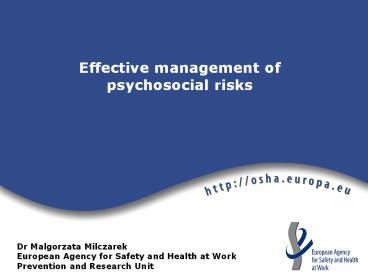Effective management of psychosocial risks - PowerPoint PPT Presentation
Title:
Effective management of psychosocial risks
Description:
Effective management of psychosocial risks Dr Malgorzata Milczarek European Agency for Safety and Health at Work Prevention and Research Unit Stress at work - facts ... – PowerPoint PPT presentation
Number of Views:274
Avg rating:3.0/5.0
Title: Effective management of psychosocial risks
1
Effective management of psychosocial risks
Dr Malgorzata Milczarek European Agency for
Safety and Health at Work Prevention and Research
Unit
2
Stress at work - facts
- Work-related stress is one of the biggest health
and safety challenges that we face in Europe. - Stress is the second most reported work-related
health problem. EU Labour Force Survey (2007) - 28 of workers reported that work negatively
affects their mental well-being - 14 of workers who reported work-related health
problems, expirienced stress, depresion,
or anxiety as the main problem - The number of people suffering from
stress-related conditions caused or
made worse by work is likely
to increase
3
Managing psychosocial risks
- Employers have an obligation to manage
work-related stress, through the Framework
Directive 89/391/EEC. - Framework agreement on work-related stress (2004)
- Framework agreement on harassment and violence at
work (2007) - National legislation
4
Managing psychosocial risks
- Stress definition and causes
- People experience stress when they perceive that
there is an imbalance between the demands made of
them and the resources they have available to
cope with those demands. - Although the experience of stress is
psychological, stress also affects peoples
physical health.
5
Managing psychosocial risks
- The key to manage psychosocial risks and prevent
work-related stress lies with the organisation
and management of work. - Risk assessment for psychosocial risks involves
the same basic principles and processes as for
other workplace hazards - Including workers and their representatives
in the process is crucial to
success.
6
Risk Assessment the 5 steps
- Consult the workers both on the hazards and
risks and on the proposed solutions
7
Identifying hazards
- Psychosocial risks
- Control Low participation in decision making,
lack of control over work methods - Organisational culture function Poor
communication, lack of definition of,
organisational objectives - Interpersonal relationships at work conflicts,
lack of social support - Role in the organisation role ambiguity, role
conflict - Career development career stagnation and
uncertainty, job insecurity - Home-work interface conflicting demands of work
and home
8
Identifying hazards
- Psychosocial risks
- Job content lack of variety, under use of skills
- Workload work pace work overload or under
load, machine pacing, time pressure - Work schedule shift working, night shifts,
inflexible work schedules, unpredictable hours,
long or unsociable hours - Environment equipment inadequate equipment
availability, suitability or maintenance, lack of
space, poor lighting, excessive noise - Organisational and individual symptoms of stress
9
Identifying hazards
- Symptoms of work-related stress
- Organisational
- absenteeism, high staff turnover, poor
time-keeping, disciplinary problems, harassment,
reduced productivity, accidents, errors, and
increased costs from compensation or health care.
10
Managing psychosocial risks
- Symptoms of work-related stress
- Individual
- Emotional irritability, anxiety, sleep problems,
depression, hypochondria, alienation, burnout,
relationship problems - Cognitive difficulty in concentrating,
remembering, learning new things, making
decisions - Behavioural abuse of drugs, alcohol, and tobacco
- Physiological back problems, weakened immunity,
peptic ulcers, heart problems, hypertension.
11
Managing psychosocial risks
- Effective procedures/measures in preventing
work-related stress include - allowing enough time for workers to perform their
tasks - providing clear job descriptions
- rewarding workers for good performance
- enabling workers to make complaints and have them
taken seriously - giving workers control over their work
- minimising physical risks
12
Managing psychosocial risks
- Effective measures in preventing work-related
stress include - allowing workers to take part in decisions that
affect them - match workloads to the capabilities and resources
of each worker - designing tasks to be stimulating
- defining work roles and responsibilities clearly
- providing opportunities for social interaction
- avoiding ambiguity in matters of job security and
career development
13
EU-OSHA publications and practical tools
- Factsheets
- Work-related stress Bullying at work
Violence at work. - Reports
- Research on Work-related Stress How to
Tackle Psychosocial Issues and Reduce
Work-related Stress. - OiRA Online interactive Risk Assessment
- Psychosocial modul to be developed
- - Micro and Small Enterprises
- - hazard identification and preventive
measures - ESENER
- The necessary expertise is lacking
- A lack of technical support or guidance
- http//www.oiraproject.eu/
14
EU-OSHA European Campaigns
- Raising-awareness campaigns
- Working on Stress (2002)
- 2014 2015 Practical solutions for
psychosocial risks - Work-related stress can be successfully managed
- Promoting tools and methods that have been
developed over the last decade to manage
work-related stress, violence and harassment - Disseminating good practice examples (at both
national EU level), including tools for
workers representatives and line managers
15
- Thank you for your attention!
EU-OSHA http//osha.europa.eu Malgorzata
Milczarek milczarek_at_osha.europa.eu































